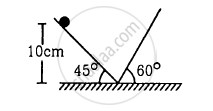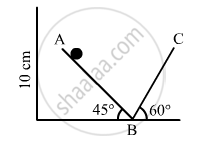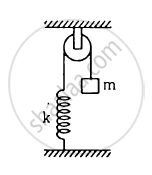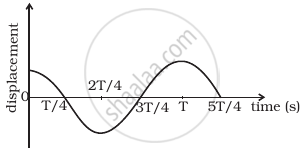Advertisements
Advertisements
Question
Find the time period of the motion of the particle shown in figure . Neglect the small effect of the bend near the bottom.

Solution

Let t1 and t2 be the time taken by the particle to travel distances AB and BC respectively.
Acceleration for part AB, a1 = g sin 45°
The distance travelled along AB is s1.
\[\therefore s_1 = \frac{0 . 1}{\sin 45^\circ} = 2 m\]
Let v be the velocity at point B, and
u be the initial velocity.
Using the third equation of motion, we have:
v2 − u2 = 2a1s1
\[\Rightarrow v^2 = 2 \times g \sin 45^\circ\times \frac{0 . 1}{\sin 45^\circ} = 2\]
\[ \Rightarrow v = \sqrt{2} m/s\]
\[As v = u + a_1 t_1 \]
\[ \therefore t_1 = \frac{v - u}{a_1}\]
\[ = \frac{\sqrt{2} - 0}{\frac{g}{\sqrt{2}}}\]
\[ = \frac{2}{g} = \frac{2}{10} = 0 . 2 \sec \ ( g = 10 {ms}^{- 2} )\]
For the distance BC,
Acceleration, a2 =\[-\]gsin 60°
\[\text { Initial velocity }, u = \sqrt{2} \]
\[ v = 0\]
\[ \therefore \text { time period }, t_2 = \frac{0 - \sqrt{2}}{- \frac{g}{\left( 3\sqrt{2} \right)}} = \frac{2\sqrt{2}}{\sqrt{3}g}\]
\[ = \frac{2 \times \left( 1 . 414 \right)}{\left( 1 . 732 \right) \times 10} = 0 . 163 s\]
Thus, the total time period, t = 2(t1 + t2) = 2 (0.2 + 0.163) = 0.73 s
APPEARS IN
RELATED QUESTIONS
The periodic time of a linear harmonic oscillator is 2π second, with maximum displacement of 1 cm. If the particle starts from extreme position, find the displacement of the particle after π/3 seconds.
Which of the following example represent periodic motion?
An arrow released from a bow.
Answer in brief:
Derive an expression for the period of motion of a simple pendulum. On which factors does it depend?
The total mechanical energy of a spring-mass system in simple harmonic motion is \[E = \frac{1}{2}m \omega^2 A^2 .\] Suppose the oscillating particle is replaced by another particle of double the mass while the amplitude A remains the same. The new mechanical energy will
A particle moves in a circular path with a uniform speed. Its motion is
The position, velocity and acceleration of a particle executing simple harmonic motion are found to have magnitude 2 cm, 1 m s−1 and 10 m s−2 at a certain instant. Find the amplitude and the time period of the motion.
The string the spring and the pulley shown in figure are light. Find the time period of the mass m.
The ear-ring of a lady shown in figure has a 3 cm long light suspension wire. (a) Find the time period of small oscillations if the lady is standing on the ground. (b) The lady now sits in a merry-go-round moving at 4 m/s1 in a circle of radius 2 m. Find the time period of small oscillations of the ear-ring.

Find the time period of small oscillations of the following systems. (a) A metre stick suspended through the 20 cm mark. (b) A ring of mass m and radius r suspended through a point on its periphery. (c) A uniform square plate of edge a suspended through a corner. (d) A uniform disc of mass m and radius r suspended through a point r/2 away from the centre.
A uniform disc of radius r is to be suspended through a small hole made in the disc. Find the minimum possible time period of the disc for small oscillations. What should be the distance of the hole from the centre for it to have minimum time period?
A body of mass 1 kg is mafe to oscillate on a spring of force constant 16 N/m. Calculate (a) Angular frequency, (b) Frequency of vibrations.
Which of the following example represent periodic motion?
A freely suspended bar magnet displaced from its N-S direction and released.
Which of the following example represent (nearly) simple harmonic motion and which represent periodic but not simple harmonic motion?
A motion of an oscillating mercury column in a U-tube.
Which of the following example represent (nearly) simple harmonic motion and which represent periodic but not simple harmonic motion?
The motion of a ball bearing inside a smooth curved bowl, when released from a point slightly above the lowermost point.
The equation of motion of a particle is x = a cos (αt)2. The motion is ______.
The displacement time graph of a particle executing S.H.M. is shown in figure. Which of the following statement is/are true?

- The force is zero at `t = (T)/4`.
- The acceleration is maximum at `t = (4T)/4`.
- The velocity is maximum at `t = T/4`.
- The P.E. is equal to K.E. of oscillation at `t = T/2`.
Show that the motion of a particle represented by y = sin ωt – cos ωt is simple harmonic with a period of 2π/ω.
A person normally weighing 50 kg stands on a massless platform which oscillates up and down harmonically at a frequency of 2.0 s–1 and an amplitude 5.0 cm. A weighing machine on the platform gives the persons weight against time.
- Will there be any change in weight of the body, during the oscillation?
- If answer to part (a) is yes, what will be the maximum and minimum reading in the machine and at which position?
When a particle executes Simple Harmonic Motion, the nature of the graph of velocity as a function of displacement will be ______.
